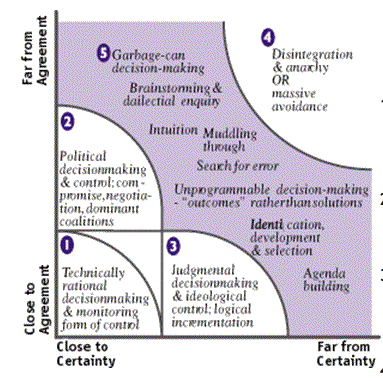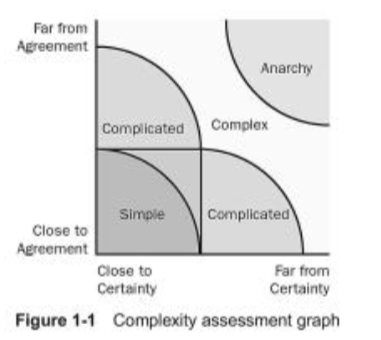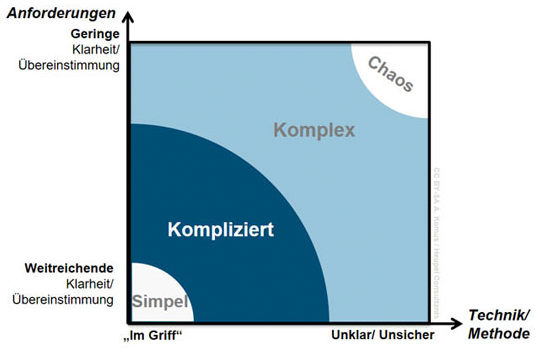How much simplification is allowed?
When does popularizing a good cause become pure populism?
A fundamental consideration using the example of the popular Stacy Matrix
We have written a new book. It's called „Hey, not so fast!“. Which is quite a flippant title. Especially when you consider the seriousness of the subject. Because it's about human perception and making complex organizational decisions. Hundreds of people smarter than us have done research in this area. So why did we write this book? Because we think that we are particularly good at one thing: explaining complicated matters very simply.
We always ask ourselves how much simplicity is allowed? When does simplification become inadmissible trivialization or even falsification? How much omission and reinterpretation is possible? Or in short: when does the attempt to popularize a good cause become pure populism?
I have an example that I would like to use to illustrate this: The “Stacey Matrix”. It is used today as a method of measuring complexity. This should serve to find out the right (project) management approach - i.e. agile or traditional. So far so good. I like the conception of agility. I agree to the idea. The problem is: the matrix has nothing to do with Stacey. And it is also not well founded at all.
I tried to trace the history of the “Stacey Matrix”.
1996-2002: Original

Stacey is a scientist. His works are gray and drab; there are five graphics on 500 pages. Or less. The said matrix comes from his first creative period (Organizational Complexity ..., 2nd ed. 1996). He tried to explain organizations as “complex adaptive systems”. In a scientific sense. He created this diagram as a model of situational leadership. The situation depends on the degree of certainty and agreement. The joke: the diagram is not a matrix at all, it was never meant to be! What Stacey was concerned with was an uncertainty paradox: If managers create plans, but the result can be proven not to be achieved through these plans (because there is disagreement / uncertainty), what do managers actually do to achieve the desired result (or to achieve something similar)? As I said, it's not that easy to understand. This is probably why it was so often reinterpreted and reduced to the simple formula: Complexity = Uncertainty * Disagreement (see the next figure “Complexity assessment graph”). That was NOT what Stacey meant! He meant the opposite: complex action as an ANSWER to situations. His original graphic gives examples of this. But too many intuitively misinterpreted the chart. It was just too good not to be true. Stacey left the crowd behind. The diagram no longer appears in its new editions.
Since 2003: Scrum

“Scrum” is a way of starting over the game. This is also the case with Ken Schwaber's famous book "Agile Project Management With Scrum". It has started over the „Stacey Matrix“ game. In the 2004 edition, the first chapter deals with “The Science of Scrum”. Schwaber uses a picture by Stacey modified by Brenda Zimmerman (see Figure 1-1) to clarify his understanding of complexity. According to Schwaber, the vertical axis means “Requirements Complexity” and the horizontal “Technology Complexity”. Why? Is not explained. It also is not very logical. After all, why should uncertainty only relate to technology (and not also to requirements)? And why should people only be able to disagree about requirements (and not also about the technology to be used)? None of these obvious questions are addressed. So what Schwaber does is not - as he claims - “science”, but the opposite of it. Because he is abusing a recognized scientific model to make his own idea popular. In doing so, he creates connections where there are none. Again: Schwaber's ideas are valuable. But Stacey's research does neither support nor justify them. Ultimately, Schwaber discredits himself with this approach. It fits, that on the book cover "Best Practices" are promoted - something we know does not work in complex systems. But “best practices” obviously help selling books. Marketing eats up the soul.
Since 2015: VUCA

Since the middle of the last decade at the latest, there has been a great "agile movement" beyond Scrum and software development. For the advocates of this movement, “agile management” is the answer to the challenges of the VUCA world. Needless to say that this is a huge market. Especially for business consultants. Consultants love to create graphics "based on Stacey". So actually based on Schwaber. Because the representations are propagated as "instruments for determining complexity". Of course these are very creative creations. The crudest modification is the addition of the term “clarity”. For example, the management consultant Katja von Bergen writes “The decision-making depends on the clarity of the goal and the way to get there.” Taken by itself, the statement is okay. But it is no longer okay as soon as it is linked to the "Stacey Matrix". Combined with the „Cynefin Framework“ and adapted by another author. So we gain an adaptation of the adaptation of the adaptation of the adaptation of the adaptation. None of these transitions are explained. This is not knowledge creation; that is knowledge destruction. What remains is homeopathic knowledge - the current variants of the "Stacey matrix" are globules: without active substance, but still working, somehow.
Here is a small, incomplete collage of the current globules that are being doctored around with.
A collage of variants of the "Stacey Matrix"

The Stacey matrix is an instrument of "storytelling" - and should be named that way!
To sum it up:
The Stacey matrix (in the current versions) has nothing to do with Stacey. In addition, the "further developments" made are arbitrary. But the whole thing seems somehow plausible. The representations are suitable to explain in which situations "agile management" becomes important. Not to explain everything and not everything correctly, but good enough to advance the “good cause”. I think that's valuable. It's just not knowledge, proof, or evidence. It is what it is: storytelling! The “Stacey Matrix” is a storytelling tool. It is suitable for telling the "agility story". No more and no less. That's why it should be named that way. That won't do - if we pass storytelling off as science or something similar - then we commit a betrayal of the matter. Because that's populism. And we would have to admit populism to others too. Others, who perhaps want exactly the opposite of what we want. And if everyone then only relies on half-truths (or less), exchange and dialog is no longer possible. Because then there is no longer any evidence and everything is just belief.
Book for better thinking:
Hey, not so fast (currently only available in German)For all, who want to dive deeper:
- Ralph Stacey, Strategic Management and Organisational Dynamics, The Challenge of Complexity to Ways of Thinking about Organisations, 7th ed, Pearson, 2015- Dave Snowden, Separated by a common language? Blogpost, Published: Oct 13, 2019, Online
- Brenda Zimmerman, Embracing Complexity, Connectivity, and Change, Talk/Video, Published: Nov 22, 2013, Online
Web sources of the "Stacey-Matrix" (not complete)
https://erfolgreich-projekte-leiten.de/stacey-matrix/https://persoblogger.de/2018/04/30/digitale-transformation-von-hr-kleine-einfuehrung-fuer-personaler-als-lern-bingo/
https://wecreation.de/content/2019/06/27/die-stacey-matrix/
https://www.solvin.com/blogdetails/wie-sie-die-richtige-projektmanagement-methode-fuer-ihr-projekt-finden.html
https://innovationsblog.dzbank.de/2018/08/02/why-agile-was-wir-aus-dem-innovationsmanagement-der-industrie-fuer-den-finanzsektor-lernen-koennen/
https://yanado.com/blog/top-4-project-management-methodologies-and-when-to-use-them/
https://www.slideshare.net/MarcinCzenko/start-small-stay-small-25715659
https://www.agile-minds.com/when-to-use-waterfall-when-agile/
https://giom.blog/2019/04/13/transformation-too-complex-for-big-plan/
https://nextlevelconsulting.com/en_us/our-focus/agile-management/agile-approaches-in-projects/?tx_felogin_pi1%5Bforgot%5D=1
https://smoothapps.com/staging/wp-content/uploads/2014/11/ModifiedStacy.png
https://workasavisual.wordpress.com/2018/12/02/the-agile-stacey-matrix/
https://www.kraus-und-partner.de/media/press/dr.-kraus-und-partner-projekte-managen-in-der-vuca-welt.pdf
https://www.visiontemenos.com/blog/agile-learning-series-scrum
https://www.business2community.com/strategy/the-problem-with-scrum-experts-02222318
https://www.itmagazine.ch/Artikel/art_bildergalerie.cfm?aid=67357&arts_idx=82113&nr=1
https://www.projektmagazin.de/artikel/mit-der-stacey-matrix-zur-richtigen-pm-methode_1128468
https://www.projektmagazin.de/artikel/wie-starte-ich-mit-scrum_1110197
https://www.slideshare.net/VALOZ/8-critical-skills-complexity
https://medium.com/grand-parade/the-cost-of-software-development-and-tips-how-to-reduce-it-60ba44e85948
https://www.kayenta.de/training-seminar/artikel/stacey-matrix-die-richtige-projektmanagement-methode-finden.html

